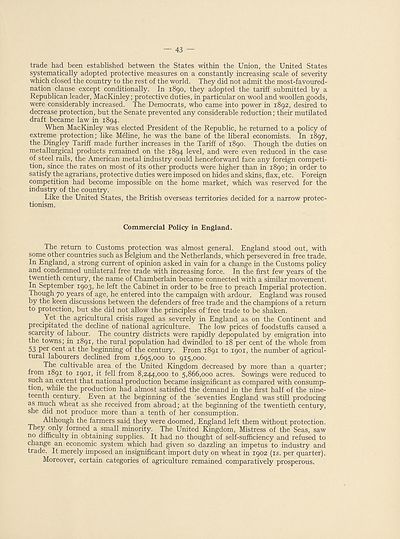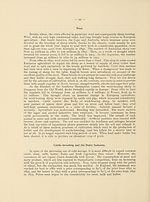Economic and financial section > Considerations on the present evolution of agricultural protectionism
(45)
Download files
Complete book:
Individual page:
Thumbnail gallery: Grid view | List view

— 43 —
trade had been established between the States within the Union, the United States
systematically adopted protective measures on a constantly increasing scale of severity
which closed the country to the rest of the world. They did not admit the most-favoured¬
nation clause except conditionally. In 1890, they adopted the tariff submitted by a
Republican leader, MacKinley; protective duties, in particular on wool and woollen goods,
were considerably increased. The Democrats, who came into power in 1892, desired to
decrease protection, but the Senate prevented any considerable reduction; their mutilated
draft became law in 1894.
When MacKinley was elected President of the Republic, he returned to a policy of
extreme protection; like Meline, he was the bane of the liberal economists. In 1897,
the Dingley Tariff made further increases in the Tariff of 1890. Though the duties on
metallurgical products remained on the 1894 level, and were even reduced in the case
of steel rails, the American metal industry could henceforward face any foreign competi¬
tion, since the rates on most of its other products were higher than in 1890; in order to
satisfy the agrarians, protective duties were imposed on hides and skins, flax, etc. Foreign
competition had become impossible on the home market, which was reserved for the
industry of the country.
Like the United States, the British overseas territories decided for a narrow protec¬
tionism.
Commercial Policy in England.
The return to Customs protection was almost general. England stood out, with
some other countries such as Belgium and the Netherlands, which persevered in free trade.
In England, a strong current of opinion asked in vain for a change in the Customs policy
and condemned unilateral free trade with increasing force. In the first few years of the
twentieth century, the name of Chamberlain became connected with a similar movement.
In September 1903, he left the Cabinet in order to be free to preach Imperial protection.
Though 70 years of age, he entered into the campaign with ardour. England was roused
by the keen discussions between the defenders of free trade and the champions of a return
to protection, but she did not allow the principles of free trade to be shaken.
Yet the agricultural crisis raged as severely in England as on the Continent and
precipitated the decline of national agriculture. The low prices of foodstuffs caused a
scarcity of labour. The country districts were rapidly depopulated by emigration into
the towns; in 1891, the rural population had dwindled to 18 per cent of the whole from
53 Per cent at the beginning of the century. From 1891 to 1901, the number of agricul¬
tural labourers declined from 1,695,000 to 915,000.
The cultivable area of the United Kingdom decreased by more than a quarter;
from 1891 to 1901, it fell from 8,244,000 to 5,866,000 acres. Sowings were reduced to
such an extent that national production became insignificant as compared with consump¬
tion, while the production had almost satisfied the demand in the first half of the nine¬
teenth century. Even at the beginning of the ’seventies England was still producing
as much wheat as she received from abroad; at the beginning of the twentieth century,
she did not produce more than a tenth of her consumption.
Although the farmers said they were doomed, England left them without protection.
They only formed a small minority. The United Kingdom, Mistress of the Seas, saw
no difficulty in obtaining supplies. It had no thought of self-sufficiency and refused to
change an economic system which had given so dazzling an impetus to industry and
trade. It merely imposed an insignificant import duty on wheat in 1902 (is. per quarter).
Moreover, certain categories of agriculture remained comparatively prosperous.
trade had been established between the States within the Union, the United States
systematically adopted protective measures on a constantly increasing scale of severity
which closed the country to the rest of the world. They did not admit the most-favoured¬
nation clause except conditionally. In 1890, they adopted the tariff submitted by a
Republican leader, MacKinley; protective duties, in particular on wool and woollen goods,
were considerably increased. The Democrats, who came into power in 1892, desired to
decrease protection, but the Senate prevented any considerable reduction; their mutilated
draft became law in 1894.
When MacKinley was elected President of the Republic, he returned to a policy of
extreme protection; like Meline, he was the bane of the liberal economists. In 1897,
the Dingley Tariff made further increases in the Tariff of 1890. Though the duties on
metallurgical products remained on the 1894 level, and were even reduced in the case
of steel rails, the American metal industry could henceforward face any foreign competi¬
tion, since the rates on most of its other products were higher than in 1890; in order to
satisfy the agrarians, protective duties were imposed on hides and skins, flax, etc. Foreign
competition had become impossible on the home market, which was reserved for the
industry of the country.
Like the United States, the British overseas territories decided for a narrow protec¬
tionism.
Commercial Policy in England.
The return to Customs protection was almost general. England stood out, with
some other countries such as Belgium and the Netherlands, which persevered in free trade.
In England, a strong current of opinion asked in vain for a change in the Customs policy
and condemned unilateral free trade with increasing force. In the first few years of the
twentieth century, the name of Chamberlain became connected with a similar movement.
In September 1903, he left the Cabinet in order to be free to preach Imperial protection.
Though 70 years of age, he entered into the campaign with ardour. England was roused
by the keen discussions between the defenders of free trade and the champions of a return
to protection, but she did not allow the principles of free trade to be shaken.
Yet the agricultural crisis raged as severely in England as on the Continent and
precipitated the decline of national agriculture. The low prices of foodstuffs caused a
scarcity of labour. The country districts were rapidly depopulated by emigration into
the towns; in 1891, the rural population had dwindled to 18 per cent of the whole from
53 Per cent at the beginning of the century. From 1891 to 1901, the number of agricul¬
tural labourers declined from 1,695,000 to 915,000.
The cultivable area of the United Kingdom decreased by more than a quarter;
from 1891 to 1901, it fell from 8,244,000 to 5,866,000 acres. Sowings were reduced to
such an extent that national production became insignificant as compared with consump¬
tion, while the production had almost satisfied the demand in the first half of the nine¬
teenth century. Even at the beginning of the ’seventies England was still producing
as much wheat as she received from abroad; at the beginning of the twentieth century,
she did not produce more than a tenth of her consumption.
Although the farmers said they were doomed, England left them without protection.
They only formed a small minority. The United Kingdom, Mistress of the Seas, saw
no difficulty in obtaining supplies. It had no thought of self-sufficiency and refused to
change an economic system which had given so dazzling an impetus to industry and
trade. It merely imposed an insignificant import duty on wheat in 1902 (is. per quarter).
Moreover, certain categories of agriculture remained comparatively prosperous.
Set display mode to:
![]() Universal Viewer |
Universal Viewer | ![]() Mirador |
Large image | Transcription
Mirador |
Large image | Transcription
Images and transcriptions on this page, including medium image downloads, may be used under the Creative Commons Attribution 4.0 International Licence unless otherwise stated. ![]()
| League of Nations > Economic and financial section > Considerations on the present evolution of agricultural protectionism > (45) |
|---|
| Permanent URL | https://digital.nls.uk/190896085 |
|---|
| Shelfmark | LN.II |
|---|
| Description | Over 1,200 documents from the non-political organs of the League of Nations that dealt with health, disarmament, economic and financial matters for the duration of the League (1919-1945). Also online are statistical bulletins, essential facts, and an overview of the League by the first Secretary General, Sir Eric Drummond. These items are part of the Official Publications collection at the National Library of Scotland. |
|---|---|
| Additional NLS resources: |
|

